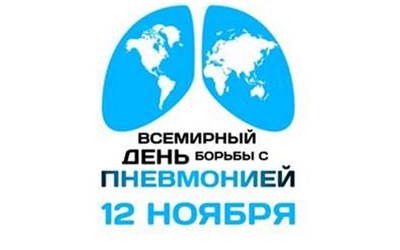 The more science advances in the study
The more science advances in the study
of causes of the disease, the more it comes to
the general provision that to warn
the diseases is much easier than curing them.
I.I. Mechnikov
World Pneumonia Day is celebrated annually on November 12. This memorable date was initiated by the Global Coalition Against Childhood Pneumonia, an organization of nongovernmental foundations, academic institutions and government agencies. The purpose of this day is to raise awareness of the population about pneumonia and to promote activities for the prevention and treatment of this disease. The symbol of the holiday is blue jeans worn by the protesters. Blue is the color of the sky, light, airy, clean, and jeans are the most democratic clothing that unites people of all ages and professions.
Currently, the problem of pneumonia continues to be one of the most urgent in practical health care, especially in the era of the COVID-19 pandemic. According to WHO statistics, pneumonia and other forms of pneumonia affect about 450 million people annually, ranking 4th among the causes of death after cardiovascular diseases, malignant neoplasms and accidents. Most often, the defeat of the lower respiratory tract occurs in the younger age group in children under 5 years of age, as well as in elderly and senile people with chronic somatic diseases. Despite the availability of modern antibacterial drugs, the number of deaths from pneumonia is increasing.
During a pandemic of a new coronavirus infection, according to Rosstat, mortality from pneumonia in the Russian Federation in 2020 increased 2.4 times (plus 34.4 thousand people). This disease is the leading cause of juvenile death worldwide. It kills 1.1 million children under the age of five every year. That’s more than AIDS, malaria and measles combined. Mortality rates from community-acquired pneumonia, in turn, can be called important indicators of the quality of medical care provided to the population.
Although most healthy children and adults are able to cope with the infection with the help of their own body’s defenses, people with risk factors such as long-term smoking, age (infants and newborns or people over 60 years of age are more likely to suffer from pneumonia), transient immunodeficiency (for example , the transferred influenza virus suppresses the immune system 6-10 times), concomitant diseases (HIV infection, systemic diseases of the connective tissue, oncohematological diseases), chronic lung diseases, as well as overwork, chronic stress, chronic fatigue syndrome, insufficient nutrition, unsatisfactory communal living conditions, the susceptibility of the respiratory system to infectious agents and the risk of developing pneumonia, including those with a severe course, sharply increase.
Considering that at present this disease is easier to prevent than to cure, the need to comply with a number of preventive measures is increasing:
– compliance with hand hygiene;
– wearing disposable respiratory protection in public places with their subsequent disposal;
– covering your nose and mouth with a sanitary napkin when coughing or sneezing;
– maintaining a healthy lifestyle (attention to physical activity, walking in the fresh air, giving up bad habits);
– with the onset of cold weather, it is necessary to follow the weather forecast and dress according to the ambient temperature, avoiding hypothermia of the body;
– observance of the modes of ventilation and wet cleaning of premises; when using air conditioners, it is necessary to monitor their cleanliness;
– special attention to vaccination against influenza, since pneumonia is often a complication of this viral disease, is very difficult and can be fatal;
– during the period of the rise in the incidence of ARVI and influenza, avoid contact with the sick, refrain from visiting places with a large crowd of people.
– when the first nonspecific symptoms of ARVI and pneumonia appear, stay at home and immediately seek high-quality medical care.
Take care of your health and the health of people around you, as L. Berne said: “There are thousands of diseases, but health is only one.”
Department of Internal Medicine, ICE
Doctor of Medical Sciences, Associate Professor E.V. Gavrilyuk
